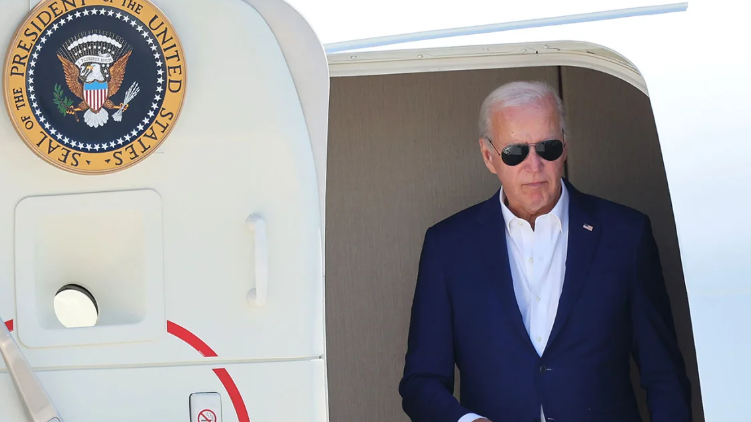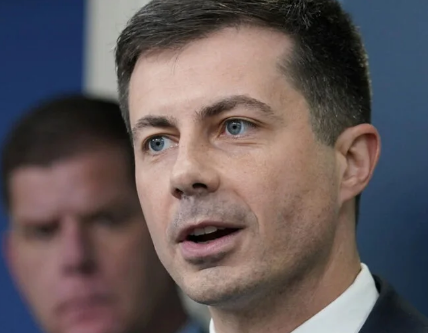
The stakes for Democrats in their extraordinary public schism over whether President Joe Biden should withdraw from the 2024 presidential race extend far beyond the White House. A decisive loss at the top of the ticket could cost Democrats control of the US Senate for the remainder of this decade and cement Republican dominance of the Supreme Court for a generation.
So far, Democratic anxiety about the presidential race’s impact on the Senate has been muted because public polling has almost invariably shown their candidates still leading in the key states where Biden has fallen behind former President Donald Trump. But recent history raises deep questions about whether Democratic Senate candidates can continue to levitate as far above the presidential ticket as polls now show.
Throughout this century, but especially over roughly the past decade, it has grown increasingly difficult for Senate candidates in either party to win in states that usually vote for the other side in presidential contests. During the 2016 and 2020 election years, Republican Sen. Susan Collins of Maine was the only candidate, out of 69 total Senate races, who won in a state that voted the other way at the presidential level.
This year, Democrats are defending an unusually large concentration of Senate seats in states that now appear at risk for them in the presidential contest. If Democrats lose a substantial number of those seats this year, it could be very difficult for them to recapture a Senate majority before these same seats come up again in 2030. The reason is that very few of the other Senate seats Republicans now hold are in states where Democrats have a realistic chance of winning, absent a dramatic change in their political balance.
In turn, extended GOP control of the Senate, coupled with a return of Trump to the White House, would give the party ample time to nominate and confirm much younger replacements for Samuel Alito (74) and Clarence Thomas (76), the two oldest and most conservative Supreme Court Justices, and possibly also Sonia Sotomayor (70), the oldest Democratic-appointed justice.
“Because of the big sorting out of the states … Democrats have a narrower path to a Senate majority than Republicans do, which means this year is crucial,” said former Democratic Sen. Evan Bayh of Indiana. “The margin of error [for Democrats] is not high, and the consequences will be with us for another six years.” If the presidential and Senate elections go badly for Democrats, Bayh added, Republicans “could change the judicial branch of government for a generation.”
Vulnerable Democratic Senate seats this year fall into three broad buckets.
The first includes three states that Trump carried in 2016 and 2020 and that he is virtually certain to win again — likely by a substantial margin. In that group, both sides concede the GOP will win the West Virginia seat being vacated by retiring Sen. Joe Manchin, who’s now an independent but still caucuses with Democrats; veteran Democratic Sens. Sherrod Brown of Ohio and Jon Tester of Montana, who have survived difficult reelections even as their states have moved right, are facing substantial challenges this year.
If Republicans win just two of those three states, they would still seize control of the Senate (absent offsetting Democratic wins in any GOP-held seats, which are unlikely). But if Democrats only lost some combination of the three 2020 Trump states, they would remain close enough to the GOP in the chamber to retain realistic hopes of recapturing the Senate in 2026 or 2028.
The real risk to Democrats is that their losses could extend beyond that inner circle of strongly red-leaning states — particularly if the presidential race goes badly. Democrats are defending five more Senate seats this year in presidential swing states where most polls now show Biden trailing, or at best running even. That list includes Democratic Sens. Bob Casey in Pennsylvania, Tammy Baldwin in Wisconsin and Jacky Rosen in Nevada, as well as Reps. Elissa Slotkin and Ruben Gallego, who are seeking open Senate seats now held by Democrats in Michigan and Arizona respectively. (Retiring Sen. Kyrsten Sinema of Arizona still caucuses with Democrats after becoming an independent.) Biden’s 2020 margin of victory was three points or less in all of those states.
As Biden’s position has weakened since last month’s CNN debate, strategists in both parties are just beginning to look at another circle of Democratic-held Senate seats in more strongly blue-leaning states where some polls have suggested an unexpectedly competitive presidential race. Topping that list are the contests in New Mexico, where Democratic Sen. Martin Heinrich is facing Nella Domenici, the daughter of the late Pete Domenici, a long-time Republican senator from the state; and New Jersey, where Republicans chose a relatively centrist nominee, Curtis Bashaw, to oppose Democratic Rep. Andy Kim in a race complicated by the possible independent candidacy of indicted Democratic Sen. Bob Menendez.
Even if the Democrats’ vulnerability ultimately does not extend to that outer perimeter, significant losses for the party in the first two circles, as I’ve written, could leave them with few paths back to a Senate majority for the remainder of this decade.
This year, the only Republican senators Democrats are targeting are Rick Scott in Florida and Ted Cruz in Texas, and Biden’s difficulties in both states leave Democrats facing huge headwinds in those races. The list of other Republican-held Senate seats that Democrats can realistically target in the years to come, based on the states’ current political leanings, is small. Republicans hold only two Senate seats in states that voted for Biden last time (Collins, who will face reelection in 2026, and Wisconsin’s Ron Johnson, who isn’t up until 2028 after narrowly winning another term in 2022). North Carolina is the only other state with Republican senators where Biden finished within 3 points of Trump in 2020 — and even there, Democrats have not won a presidential or Senate contest since 2008.
Beyond these four seats — Maine, Wisconsin and the two in North Carolina — Democrats have no more tempting targets before 2030 among Republican-held Senate seats than Florida, Iowa and Ohio, all of which are long shots for them. Meanwhile, Democrats will have another round of their own swing state Senate seats to defend over those two elections.
All of this means the seats Democrats could lose this year if the presidential ticket drags down their Senate nominees in states such as Michigan, Nevada and Arizona are virtually irreplaceable for them. “A Democratic Senate majority coalition relies on having both Senators from a state such as Michigan,” said Daniel Hopkins, a University of Pennsylvania political scientist. Absent a major external event, such as an economic crash while Republicans hold the White House, “if the Democrats don’t hold their own in the Senate this year, it is hard to see how they recover” before 2030, he added.
The prospect that Biden’s eroding position could produce a lasting Senate deficit — which, in turn, could allow Republicans to further reshape the federal judiciary, including the Supreme Court — hasn’t produced panic among Democrats yet because of the public and private polls consistently showing their Senate candidates running well ahead of the president. “What’s true before the debate is true after: for voters, Senate campaigns are candidate vs. candidate battles,” said David Bergstein, communications director for the Democratic Senatorial Campaign Committee.
Optimistic Democrats believe the personal vulnerabilities of the GOP challengers — which include a disproportionate number of wealthy business people without much, or any, prior political experience — will allow their candidates to survive even a substantial undertow in the presidential contest. “Republicans have a roster of deeply flawed recruits, and we’ll win because we have the better candidates,” Bergstein said.
But Republicans say the Democratic advantage in these races is only temporary. “Our challengers are still building name ID, which is the reason they are lagging the Presidential ballot at this point,” Mike Berg, communications director for the National Republican Senatorial Committee, said in an email. “Expect the horse race numbers to tighten significantly as Republican candidates begin advertising more heavily. The more important number to look at right now is the ballot share the [Democratic] incumbents are receiving – which is consistently below 50 in our target states.”
Lee Drutman, a senior fellow in the political reform program at New America, a center-left think tank, likewise thinks “it seems unlikely that you could have as big of a gap” between Biden and Democratic Senate candidates as polls now show. While many of the GOP nominees are weak, Drutman said, Biden’s struggles could depress Democratic turnout in a way that hurts the party up and down the ballot. “If Democrats stick with Biden after all this,” Drutman predicted, “I would expect Democratic voter enthusiasm to plummet.”
Many Democratic pollsters and operatives are also nervous about the contrast between current polling and recent history. One leading Democratic pollster, who asked for anonymity while discussing campaign strategy, told me that in several of the swing states, post-debate polls show Democratic Senate candidates clinging to small leads while Biden has fallen substantially behind Trump. “I just don’t know if we can hold that kind of gap,” the pollster said. “You are setting up the classic dynamic where the Senate candidates have to win with people who are not voting for him [Biden].”
Jason Kander has experience trying to navigate those treacherous waters. In 2016, as the Democratic Senate candidate in Missouri, Kander ran over 8 percentage points ahead of presidential nominee Hillary Clinton, one of the widest gaps anywhere in the country that year. But when Clinton lost the state by almost 525,000 votes, Kander still fell short against Republican Sen. Roy Blunt.
Kander said that it is impossible for any Senate candidate to completely escape the gravitational pull of the presidential contest. “The presidential race doesn’t just dominate politics, it dominates popular culture during a presidential year,” he told me. “Nearly everything is a response to that. Not just in politics, but in everything.”
Kander said he believes it will be easier for incumbent senators, who have longer relationships with voters, to establish an identity separate from the presidential nominee than it was for him as a challenger. But, in either circumstance, he believes the key to outrunning the presidential ticket is to convey authenticity and independence.
That doesn’t require, he said, breaking from the presidential ticket on high-profile policy issues: “I can’t even think of an issue where it would be in the political interest of a candidate to break from Biden this year, with the exception of regional issues,” he said. But it does demand, he believes, that candidates show themselves to be genuinely rooted in the values and experiences of their state.
Given that necessity, Kander said that it would be a mistake for the White House to demand that Democrats unwaveringly dismiss voter concerns about Biden’s age.
“If what happens in this election is President Biden asks down-ballot candidates to go to voters and say that they have zero concerns whatsoever and what they saw in the debate didn’t bother them at all, there is a possibility that you are asking them to sacrifice some credibility in the exact same way that President Trump did in the mid-terms when he required a lot of candidates to go out and say that the election was rigged,” Kander said. “A lot of independent voters looked at that and said that makes me question your credibility on every other argument you are making.”
Bayh, who had stepped down from the Senate in 2010, also ran on that 2016 ballot with Clinton when he tried to regain an open Indiana Senate seat. Bayh ran about 5 points ahead of her, but fell to Republican Todd Young when Clinton lost Indiana by about 525,000 votes.
Bayh told me that over the course of his political career, which included two elections as Indiana’s governor beginning in 1988, the number of voters willing to vote for presidential candidates of one party and lower-ballot candidates of the other markedly declined, especially in congressional and Senate races. In many ways, he said, that has been a rational response from voters to the transformation of the House and Senate into quasi-parliamentary institutions with much higher levels of party-line voting than through most of the 20th century.
“The public has kind of looked at that and figured it out that it’s become more parliamentary,” he said. “You see a dramatic decline in split ticket voting and much more people voting red team or blue team.”
That shift has accelerated in recent years.
As recently as the 1980s, it was common for voters to split their tickets in Senate races. After Ronald Reagan’s landslide victory in 1984, for instance, Democrats still controlled about half the Senate seats in the states that voted for him both times — many of them conservative Southern states still unwilling to vote for Republicans below the presidential level.
By 2012, though, Democrats held over four-fifths of the Senate seats in the states that twice voted for Barack Obama while Republicans held more than three-fourths of them in the states that twice voted against him.
Still, even that alignment left room for some Senate candidates to swim against this general tide. When Obama was first elected in 2008, six Democrats won in states that voted against him, and Collins won in Maine, which voted for him. In Obama’s 2012 reelection, five other Democratic Senate candidates won in states that voted against him, while Republican Dean Heller won in Nevada, which supported Obama.
Since 2012, though, voters have relentlessly pruned these “mismatched” Senate candidates. In the 2014 and 2018 midterm elections, Democrats lost nine of the 11 Senate seats they won in states that voted against Obama during his two presidential races. And while Collins was reelected in 2014, Heller — the only other GOP senator elected in a state that voted Democratic during Obama’s two races — was defeated in 2018.
In the presidential election years, the pull of the presidential outcome on Senate results has become even more profound. In 2016, for the first time since the direct election of senators, all 34 Senate races went the same way as the presidential result in that state; in 2020, when 35 Senate contests (including two special elections) were held, only Collins defied the presidential outcome.
The 2020 results demonstrated the strength of this current most powerfully in the failed Democratic attempt to capture six GOP-held Senate seats in Republican leaning states. Democratic Senate challengers that year in Iowa, Kansas, Kentucky, Montana, South Carolina, and Texas spent a combined $382 million on their campaigns, a remarkable sum. And yet when Biden lost those states, so did all six Democratic challengers. Despite the huge sums the six raised and spent, Montana’s outgoing Democratic Gov. Steve Bullock was the only one among them who ran more than 2.1 percentage points ahead of Biden in their state.
In those races, Republicans recognized they could win even if the Democratic candidates outspent them or maintained relatively favorable personal images, said Republican consultant Jesse Hunt, who served as the NRSC’s communications director in 2020. “As long as everything was kept close, we knew the sheer atmospherics” of the presidential race would tip the result, he said. “Money, personal popularity, image and name identification don’t actually matter if the margin at the top of the ticket is overwhelming.”
Like other Republicans, Hunt believes that these historic trends in Senate races mean that the Democrats now clinging to their leads as Biden slips “are all at risk.” Several Democratic sources told me the party senators on the ballot this year are acutely aware that just one of the 69 Senate races in 2016 and 2020 favored the party that lost the presidential race in that state.
This history, by itself, doesn’t answer whether Democratic Senate candidates would have better prospects with or without Biden as their presidential nominee. But it does tell them that the consequences of the party’s choice on whether to stick with Biden are certain to reverberate beyond the White House.
“Democrats certainly cannot rely on the idea that Senate races will be decoupled from the presidential race,” said Hopkins, the political scientist, “because they won’t.”



